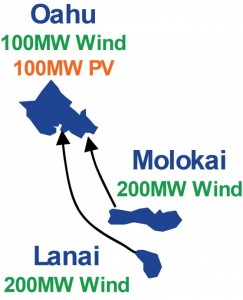STUDY: Molokai, Lanai Could Supply 25% Oahu Energy
By Sonia Isotov
Wind and solar farms on Molokai and Lanai could supply up to 25% of Oahu’s electricity, according a study released yesterday by the Hawaii Natural Energy Institute (HNEI).
In partnership with the Hawaiian Electric Company (HECO) and General Electric Company, HNEI studied the impacts to the HECO grid of integrating 400 MW of wind power from Molokai and Lanai supplied through an undersea cable combined with 100 MW of wind and 100 MW of solar power located on O’ahu.
The electricity supplied from these sources would reduce Hawaii’s fossil fuel consumption by approximately 2.8 million barrels of low sulfur fuel oil and 132,000 tons of coal each year. The study indicated that HECO can reliably integrate this new solar and wind power and supply 25% of Oahu’s electricity. That is, if several recommendations for upgrades to the HECO grid and requirements for the wind projects are followed.
The February 2011 “Oahu Wind Integration Study” final report was prepared by University of Hawaii, Hawaii Natural Energy Institute’s School of Ocean and Earth Science and Technology, and prepared for the U.S. Department of Energy’s Office of Electricity Delivery and Energy Reliability.
The General Electric Company (GE) conducted the analyses contained in this report, which was co-funded and overseen by the Hawaii Natural Energy Institute (HNEI) and Hawaiian Electric Company (HECO). AWS Truepower and the National Renewable Energy Laboratory (NREL) provided data for the study. NREL also helped organize a Technical Review Committee (TRC) that provided technical guidance for the project team.
The 229-page study details specific modeling and scenario analyses and includes renewable energy integration strategies and sub-hourly analysis. Eight recommendations address wind plants, centralized solar PV plants, signals exchanged between wind/solar plants and system operations, Energy Management Systems, operation strategies, HVDC requirements, and thermal units.
The National Renewable Energy Laboratory (NREL) organized a technical review committee of U.S. and world experts in large-scale integration of wind power that met throughout the study to provide technical expertise, review results and distill recommendations.
See the O’ahu Wind Integration Study for the full report.











